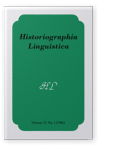Toward a religious-colonial linguistic model of early Hindi Grammars
The aim of this paper is three-fold: to call for a re-examination of the early Hindi grammars; secondly, to demonstrate that the grammars in question follow a unique model of language which can best be characterized as the ‘religious-colonial’ model; and finally, to argue that the existing criteria used to evaluate the traditional grammars cannot be indiscriminately applied to the grammars in question and, therefore, a set of new evaluationary criteria is required to arrive at the satisfactory perception of the grammars. The grammars depart from the perception of language embodied in the traditional prescriptive grammars. Compromising between the sociological and a purely linguistic view of language, the grammars are sometimes delinquent in presenting an accurate description of the language. However, treated as socio-historical data, they constitute a rich storage of sociolinguistic information which awaits exploitation by linguists working in the area of socio- and psycholinguistics in general and Hindi linguistics in particular. The claims made in the paper are supported by the analysis of the data drawn from the three oldest grammars of Hindi, primarily, from the oldest grammar, namely, that by Joan Josua Ketelaar (1659–1785?) of 1698, and secondarily, from those of Benjamin Schultze (1689–1760) of 1745 and of Cassino Beligatti (1708–1785?) of 1771.
References
Bhatia, Tej K.
1982 “
In Search of the Oldest Grammar of Hindi”.
South Asia Review 821.214–27.


Bhatia, Tej K.
1983 “
The Oldest Grammar of Hindustani”
Syracuse Scholar 4:3.81–101.

Bhatia, Tej K.
A History of the Hindi Grammatical Tradition. Leiden: E.J. Brill. (In press.)
Beligatti, Cassino
1771 Alphabetum Brammhanicum sev indostanum universitatis Kasí. Ed. by
Giovanni Cristoforo Amaduzzi [(1740–1792)] Rome: Typis Sac. Congregationis de Propaganda Fide.

Bloomfield, Leonard
1933 Language. New York: Holt, Rinehart & Winston.

Chaudhari, Ananta
1972 Hindī vyākarana kā itihās [
History of Hindi grammar]. Patna: Bihar Hindi Granth Academy.

Chatterji, Suniti K.
1933 “
The Oldest Grammar of Hindustani”.
Indian Linguistics 21.68–83.

Dvivedi, Mahavir Prasad
1967 “
Sar viliam jonza ne sanskrit kaise sikhi? [How did Sir William Jones learn Sanskrit?]”.
Intermediate Hindi ed. by
Usha S. Nilsson, 86–92. Madison: Indian Language and Area Center, Univ. of Wisconsin.

Grierson, Sir George
1895 Proceedings of the Asiatic Society of Bengal.
May, pp.88–90.

Grierson, Sir George
1916 Linguistic Survey of India. Vol. IX1. New Delhi: Motilal Banarsidass.

Jadhava, Panjabarava
1973 Hindī bhāshā aura sāhitya ke adhyanana men īsaī mishnariyon kā yogadana [
The contributions of Christian missionaries to Hindi language and literature]. Poona: Karmavir Prakashan. (See esp. pp.48–71.)

Ketelaar, Joan Josua
1698 Instructie off onderwijsinge der Hindostane en Persianse talen evens hare declinatie en conjugatie…[etc.]
. Ms. no. C-76. The Hague: Royal Archives.

Mills, David
ed. 1743 “
Grammatica Hindustanica”.
Dissertationes Selec-tae, 455–88. Leiden: C. Wishoff & G.J.Wishoff.

Shrivastava, Murlidhar
1973 Hindī ke yuropīya vidvān: Vyaktitava aura krititva [
European scholars of Hindi: Personality and Contribution]. Patna: Bihar Hindi Granth Academy. (See esp. pp. 185–265.)

Schult(z)e, Benjamin
1745 Grammatica Hindostanica, collectis in diur-tuna inter Hindostanos… Ed. by
Johann Heinrich Callenberg [(1694–1760)] Halle/S.: In typographia Instituti judaici.

Staal, J(ohan) F(rits)
ed. 1972 A Reader on the Sanskrit Grammarians. Cambridge, Mass: MIT Press.

Vechoor, Mathew
ed. 1976 Hindī ke tīn prārambhik vyākarāna [
Three early Hindi grammars]. Allahabad: St. Paulus Prakashan.

Vedalankar, Sharadevi
1969 The Development of Hindi Prose Literature in the Early Nineteenth Century. Allahabad: Lokbharati Publications.

Vogel, J(ean) Ph(ilippe
1871–1951). 1935 “
Joan Josua Ketelaar of Elbing, Author of the First Hindustani Grammar”.
BSOAS 31.817–22.

Vogel, J(ean) Ph(ilippe
1871–1951). 1941 De eerste ‘grammatica’ van het hindostansch. Amsterdam: Noordhollandsche Uitgevers Maatschappij, 32 pp.

Cited by
Cited by 1 other publications
This list is based on CrossRef data as of 3 july 2024. Please note that it may not be complete. Sources presented here have been supplied by the respective publishers.
Any errors therein should be reported to them.
